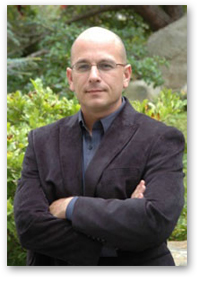Book highlights dangers of 'narrative IEDs' -- and how to counter them
SF State professor explores threat caused by rumor and ways to prevent it from becoming destructive
SAN FRANCISCO, Aug. 16, 2012 -- When Daniel Bernardi arrived in Indonesia as part of the U.S. Navy Pacific Partnership mission in 2010, he knew the potential for rumor to undermine the military's humanitarian efforts.

SF State Professor and Chair of Cinema Daniel Bernardi.
To keep that from happening, Bernardi -- now the chair of the Cinema Department at San Francisco State University -- and his Navy colleagues took proactive steps to keep rumor from taking hold, preventing it from disrupting military operations and helping ensure a successful mission.
"Narrative Landmines," a new book by Bernardi, Pauline Hope Cheong, Chris Lundry and Scott W. Ruston, highlights the importance of recognizing and countering potentially destructive rumors. The book examines three regional case studies and details the steps taken during Pacific Partnership 2010 to identify and deal with rumors.
The authors refer to rumors as "narrative IEDs," comparing them to improvised explosive devices that insurgents in Iraq and other countries have used against U.S. troops. Like physical IEDs, narrative IEDs are low-cost, low-tech weapons constructed locally that can be used by anyone to disrupt the efforts of larger and more sophisticated forces. And just as physical IEDs hide in the ground, unseen until they detonate, Bernardi says that narrative IEDs hide within the "narrative landscape" -- the complex system of narratives prevalent within a specific social, economic and political environment.
"Most rumors are duds," Bernardi said. "But a few rumors are consequential, and when they're consequential, they're actually explosive. They lead to great violence and, in some cases, government-level lies and propaganda."
In 2005, a destructive rumor surfaced in Iraq, where multinational forces began a cattle vaccination program aimed at protecting food supplies. Rumors quickly spread that U.S. troops were poisoning cattle and, unchecked, helped fuel the insurgency.
The bovine poisoning rumor spread to Indonesia and was still present when the Navy arrived for the Pacific Partnership mission, which included cattle vaccination. In addition, U.S. forces arrived in a region of the country fraught with tension between Christians and Muslims, on boats marked with the symbol of the International Red Cross -- a symbol that could be easily misinterpreted by native Muslims as that of modern-day crusaders.
To prevent falsehoods about the Pacific Partnership from arising and undermining the mission, Bernardi and his Navy colleagues needed to fill "gaps" in the narrative landscape -- the places where lack of information leads to the spread of rumor as people try to explain the inexplicable with stories that make sense within the narrative landscape.
"We embedded local journalists -- one from TV, one from print and one from radio -- on a veterinarian project high in the mountains," Bernardi said. "We gave them free access to the military and NGO veterinarians, as well as our leadership. They saw for their own eyes what we were doing and then reported it. The bovine poisoning rumor died."
Funded by a $1.6 million grant from the U.S. Department of the Navy, Bernardi and researchers from SF State and Arizona State University are continuing to study the impact of rumor on counterinsurgency operations. Their goal is to build a database to allow soldiers in the field to track rumors, determine which have the power to become weapons and offer suggestions for "disarming" them before they do significant damage. The researchers are also developing a model to show how rumors change and spread at different speeds as they move across media in the region.
###
SF State is the only master's-level public university serving the counties of San Francisco, San Mateo and Marin. The University enrolls nearly 30,000 students each year and offers nationally acclaimed programs in a range of fields -- from creative writing, cinema and biology to history, broadcast and electronic communication arts, theatre arts and ethnic studies. The University’s more than 212,000 graduates have contributed to the economic, cultural and civic fabric of San Francisco and beyond.